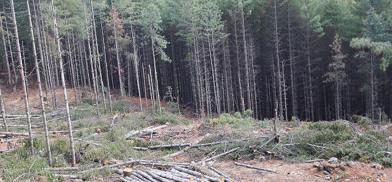4,000 wildlife crimes in the last three years in Bhutan
In the past three years, about 4,000 forest crimes were reported in Bhutan from which illegal activities related to timber and wildlife poaching topped the list

In the past three years, about 4,000 forest crimes were reported in Bhutan from which illegal activities related to timber and wildlife poaching topped the list. The crimes have reportedly increased by the year. The average crime committed within 2017-2019 was 1,300.
With 795 cases, the forest department last year recorded the highest number of misdemeanors in timber extraction. Timber related cases involved the misuse of rural timber and other surplus timber.
In 2019, 49 poaching and 504 fishing cases were reported.
According to forest facts and figures from 2017 until last year, more than half of the offenses were related to timber followed by wildlife poaching and fishing.
The records showed that between 2016 and 2018, fines collected from wildlife crimes amounted to Nu 67 million. In 2017, fishing and wildlife poaching accounted for a total of 149 cases and in 2018, 40 poachers were caught. Crimes included hunting and poaching of wild animals and its parts, smuggling and their illegal sale.
Other crimes against wildlife are illegal extraction of forest resources for food and resources, bush meat killing, fishing, forest encroachment, retaliatory killing, and forest fire.
Animals such as tiger, clouded leopard, Asian elephant, bear, Himalayan monal and musk deer are poached for skin, ivory, musk, medicine, and bones, among others.
United Nations Office on Drugs and Crime’s (UNODC) recent wildlife crime report: trafficking in protected species found that while the number of seizures of tigers and their parts remains small, the number has risen from 2007 to 2018.
Thailand and India are the main source countries for these seizures, although sourcing from Nepal, Bangladesh, and Bhutan is also ongoing.
Nearly 6,000 species have been seized between 1999-2018, including not only mammals but reptiles, corals, birds, and fish. Suspected traffickers of some 150 nationalities have been identified, illustrating the fact that wildlife crime is a global issue.
The forest department noted that offense and illegal cases are still a major challenge in the country.
An official with the forest protection and enforcement division said that those animals that have high market value were vulnerable to wildlife crimes, mostly species-based. The magnitude of illegal trade in wildlife products, however, is relatively unknown.
“Crimes against plants are hard to detect because it is difficult to break the chain of transboundary organised crime,” he said.
Red sanderwood, for example, is smuggled from India to China in different forms of consignments, he said.
Due to stringent measures to control Covid-19 and border restriction, cross border wildlife trade has reduced but the crime within the country might be ongoing, said the official.
He said that meat import restrictions could encourage bush meat killing and rampant fishing. “Once there is a shortage in the market, peoples’ dependency on natural resources increase,” he said.
As of now, about 600 forest officials are deployed across the country for border patrolling.
UNODC’s report also stated that the illegal trade in wildlife, which by definition does not go through proper sanitary and phytosanitary controls, can potentially lead to the spread of zoonotic diseases, such as SARS-CoV-2 that caused the Covid-19 pandemic.
Although the crimes undergo legal proceedings, due to the clandestine nature of the crime, it has been noted that the low risk of detection provides impunity to criminals. The defaulters are charged according to forest rules and regulations.
The national zero poaching strategy has also been developed to strengthen the anti-poaching and surveillance programmes to ensure safe protection of the wildlife in Bhutan along with transboundary networking and information sharing.
“To enhance reporting, SMART tool for species monitoring, wildlife crime hotspot mapping, and human-wildlife conflict predation mapping are also in place,” the official said.
UNODC recommended supporting law enforcement agencies in range, transit and destination states require additional technical and financial assistance to address capacity gaps, including help to better prevent, detect and investigate wildlife trafficking, and better training and protocols on how to secure and deal with specimens once seized or confiscated.
https://kuenselonline.com/4000-wildlife-crimes-in-last-three-years/









Post a Comment